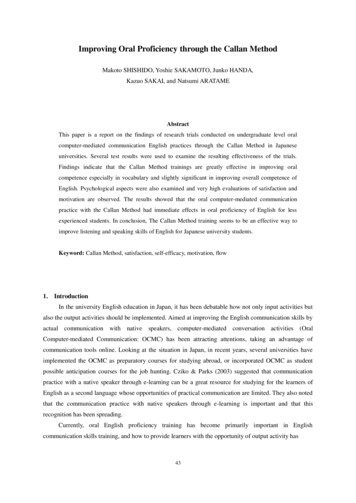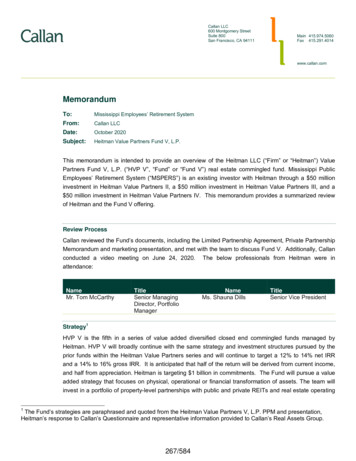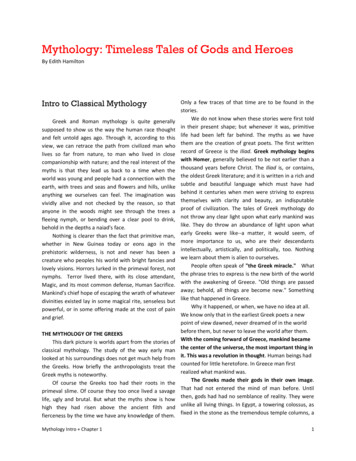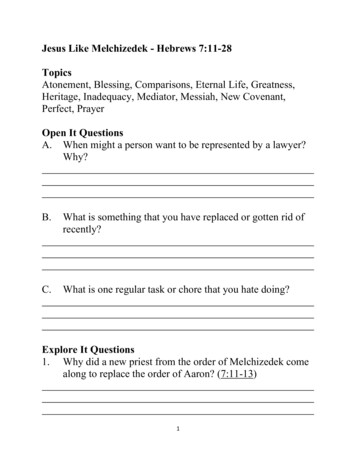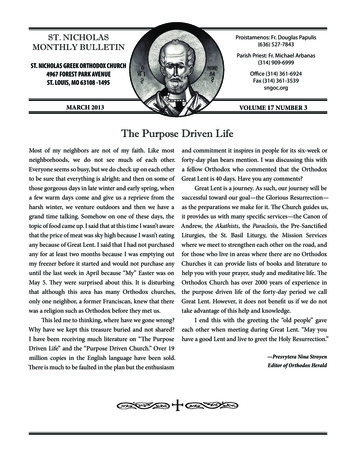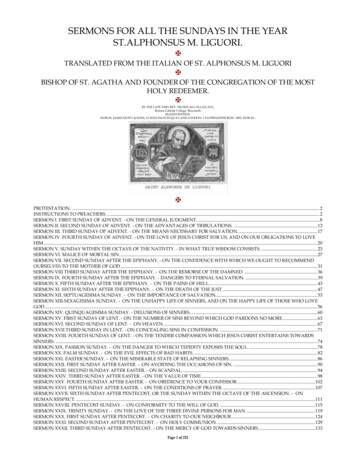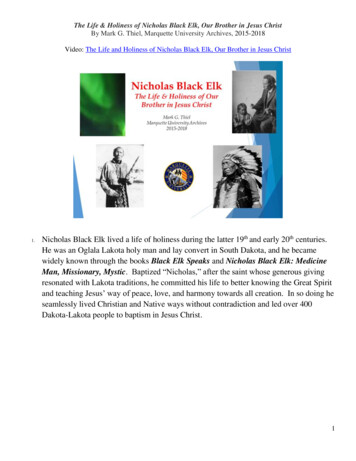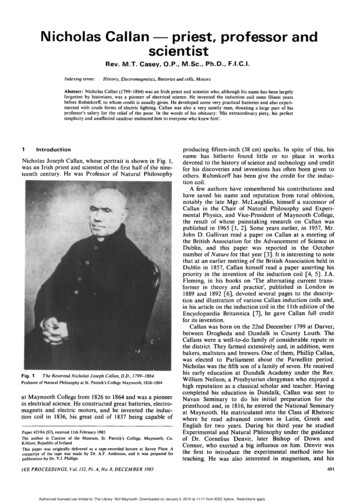
Transcription
Nicholas Callan — priest, professor andscientistRev. M.T. Casey, O.P. M.Sc. Ph.D. F.I.C.I.Indexing terms:History, Electromagnetics, Batteries and cells, MotorsAbstract: Nicholas Callan (1799-1864) was an Irish priest and scientist who, although his name has been largelyforgotten by historians, was a pioneer of electrical science. He invented the induction coil some fifteen yearsbefore Ruhmkorff, to whom credit is usually given. He developed some very practical batteries and also experimented with crude forms of electric lighting. Callan was also a very saintly man, donating a large part of hisprofessor's salary for the relief of the poor. In the words of his obituary: 'His extraordinary piety, his perfectsimplicity and unaffected candour endeared him to everyone who knew him'.1IntroductionNicholas Joseph Callan, whose portrait is shown in Fig. 1,was an Irish priest and scientist of the first half of the nineteenth century. He was Professor of Natural PhilosophyFig. 1The Reverend Nicholas Joseph Callan, D.D., 1799-1864.Professor of Natural Philosophy at St. Patrick's College Maynooth, 1826-1864at Maynooth College from 1826 to 1864 and was a pioneerin electrical science. He constructed great batteries, electromagnets and electric motors, and he invented the induction coil in 1836, his great coil of 1837 being capable ofPaper 4219A (S7), received 11th February 1985The author is Curator of the Museum, St. Patrick's College, Maynooth, Co.Kildare, Republic of IrelandThis paper was originally delivered as a tape-recorded lecture at Savoy Place. Atranscript of the tape was made by Dr. A.F. Anderson, and it was prepared forpublication by Dr. V.J. PhillipsIEE PROCEEDINGS,producing fifteen-inch (38 cm) sparks. In spite of this, hisname has hitherto found little or no place in worksdevoted to the history of science and technology and creditfor his discoveries and inventions has often been given toothers. Ruhmkorff has been give the credit for the induction coil.A few authors have remembered his contributions andhave saved his name and reputation from total oblivion,notably the late Mgr. McLaughlin, himself a successor ofCallan in the Chair of Natural Philosophy and Experimental Physics, and Vice-President of Maynooth College,the result of whose painstaking research on Callan waspublished in 1965 [1, 2]. Some years earlier, in 1957, Mr.John D. Gallivan read a paper on Callan at a meeting ofthe British Association for the Advancement of Science inDublin, and this paper was reported in the Octobernumber of Nature for that year [3]. It is interesting to notethat at an earlier meeting of the British Association held inDublin in 1857, Callan himself read a paper asserting hispriority in the invention of the induction coil [4, 5]. J.A.Fleming, in his books on 'The alternating current transformer in theory and practice', published in London in1889 and 1892 [6], devoted several pages to the description and illustration of various Callan induction coils and,in his article on the induction coil in the 11th edition of theEncyclopaedia Britannica [7], he gave Callan full creditfor its invention.Callan was born on the 22nd December 1799 at Darver,between Drogheda and Dundalk in County Louth. TheCallans were a well-to-do family of considerable repute inthe district. They farmed extensively and, in addition, werebakers, maltsters and brewers. One of them, Phillip Callan,was elected to Parliament about the Parnellite period.Nicholas was the fifth son of a family of seven. He receivedhis early education at Dundalk Academy under the Rev.William Neilson, a Presbyterian clergyman who enjoyed ahigh reputation as a classical scholar and teacher. Havingcompleted his education in Dundalk, Callan was sent toNavan Seminary to do his initial preparation for thepriesthood and, in 1816, he entered the National Seminaryat Maynooth. He matriculated into the Class of Rhetoricwhere he read advanced courses in Latin, Greek andEnglish for two years. During his third year he studiedExperimental and Natural Philosophy under the guidanceof Dr. Cornelius Denvir, later Bishop of Down andConnor, who exerted a big influence on him. Denvir wasthe first to introduce the experimental method into histeaching. He was also interested in magnetism, and hisVol. 132, Pt. A, No. 8, DECEMBER 1985Authorized licensed use limited to: The Library NUI Maynooth. Downloaded on January 5, 2010 at 11:11 from IEEE Xplore. Restrictions apply.491
influence largely determined the direction of Callan'sfuture researches. As Mgr. McLaughlin prettily puts it:'Denvir was the flint that struck the first spark of scientificinquisitiveness from the Callan steel' [1]. Callan finishedthat year high up in the prize lists which show NicolausCallan Armacanus in the first premium block in thesubject of 'Mathesios et Philosophia Naturalis'.Having completed his literary and scientific studies,Callan now entered the Divinity School where, for threemore years, he read Dogma and Moral Theology, SacredScripture and Canon Law and, on completion of his ordinary theological course in 1822, he was elected to a studentship on the Dunboyne Establishment, set up to enablethe more distinguished students to engage in higherstudies. He was ordained priest on 24th May 1823 and, byhis early ordination in his 24th year, he forfeited a considerable legacy to which was attached the stipulation thathe should not take priestly orders until he was 26 yearsold. On completion of his studies in 1824 he was sent toRome, where he attended lectures in the Sapienza University and obtained a Doctorate in Divinity in 1826.During his stay in Rome he became acquainted with theworks of Galvani and Volta. On the resignation of Dr.Denvir, his former Professor, he applied for the Chair and,after the Concursus of 1826, he was appointed to it by theTrustees on 15th September 1826. The college at Maynooth had been founded in 1795 by the Irish Parliament,for the education of Catholic Clergy. Prior to that dateclerics were educated in various Irish colleges on the continent. During the revolutionary period it was feared thatIrish students going to these colleges would imbibe 'pernicious revolutionary ideas', and so the governmentthought it better that they should be educated at home.The Trustees, 21 in all, were appointed by the governmentand comprised the Lord Chancellor as Chairman, withthree high-ranking statesmen, the four Catholic Archbishops, three Bishops, three Catholic Peers with two Baronets, Rev. Dr. Hussey, the first President, and threelaymen. There were ten Professorial Chairs in the Collegeand Professors had to undergo a 'concursus' or publicexamination before appointment. The Chair of 'Naturaland Experimental Philosophy' to which Callan wasappointed embraced mathematics, mechanics, astronomy,and such experimental sciences as existed at that period.With characteristic ardour, the new Professor embarkedon his task of teaching. For texts, he used Darre's Treatiseon Geometry and Trigonometry, which he incorporatedinto his own 'Praelectiones'. Part 1 of these 'Praelectiones'deals with conic sections, mechanics and optics. Part 2 isa clear introduction to practical astronomy. Like Newtonhimself in his 'Principia', Callan employs a good deal ofEuclidean style of definition and demonstration. A specialsection is devoted to the systems of the world, from thePtolomaic to the Copernican, the merits and demerits ofeach being argued out. Kepler's laws and the work ofTycho Brache come in for particular mention and study.This 'Gentleman's Course', inaugurated and developed byCallan, remained an integral part of the Maynooth curriculum until 1910, when the college came under the NationalUniversity of Ireland.However, it was in the field of electricity that Callanshowed his real inventive genius. To appraise hisresearches in these fields, it will be of advantage to consider them under various headings, all closely interrelated,but not in chronological order, since many of hisresearches were undertaken simultaneously. We shall takethem in the following sequence: electromagnets and theinduction coil; electric motors; and batteries.4922Electromagnets and the induction coilWith the advent of batteries, it was soon discovered that acoil of wire carrying a current became magnetic, and thecoil, when wrapped around an iron bar, rendered it magnetic [8]. In England, Sturgeon and Faraday constructedpowerful electromagnets, and so did Callan. Several ofthem are still kept in the Maynooth College Museum. Thegreat horseshoe magnet (Fig. 2) stands nearly six feet (2 m)Fig. 2Callan's large horse-shoe electromagnet; also, his 'repeater'mechanism[Photo, courtesy Irish Electricity Supply Board]in height and the diameter of the poles is about two and ahalf inches (6.35 cm). It weighs approximately two hundredand ten pounds (9.5 kg) and the iron work was done byJames Briody, the village blacksmith. Callan wound heavycopper wire, insulated by wrapping tape around it, on thepoles; this was in the late 1820s long before insulated wirecame upon the market. (It was the Henley Company whofirst manufactured insulated wire in any quantity in about1838 or 1839 [9].) This huge electromagnet of Callan's hada lifting power of some two tons when supplied withcurrent from his battery. He constructed several electromagnets varying in length and shape and used them fortesting his batteries; the greater the lifting power, thebetter the battery. He was influenced by the work of Henry[10] and Page [11] in America, who independently discovered self-induction by interrupting the current flowingthrough a spiral of copper ribbon. They felt a slight shockif the ends of the ribbon were held in the hands. Callanintroduced copper wire in place of the ribbon of Henryand Page and, more importantly, he wound the wire, insulated with tape, on an iron core and obtained shocks ofgreater intensity [5, 12]. Fig. 3 shows a selection ofCallan's coils. In one of his first coils he wound twoIEE PROCEEDINGS, Vol. 132, Pt. A, No. 8, DECEMBER 1985Authorized licensed use limited to: The Library NUI Maynooth. Downloaded on January 5, 2010 at 11:11 from IEEE Xplore. Restrictions apply.
lengths of copper wire, each two hundred feet (61 m) long,around a straight iron bar of one inch (2.54 cm) diameter.Fig. 3A selection of Callan's coils[Photo, courtesy Irish Electricity Supply Board]The two windings were joined in series but the current wassent only through one winding, whilst the shock was takenfrom the full four-hundred feet (122 m) of coil; i.e. it wasan auto-transformer' arrangement. Used with one of hiscells, this apparatus gave shocks of great intensity. In fact,he used this as one method of testing the power of hisbatteries. He persuaded his students to take shocks from it,and from the reactions of the students, he judged thepower of the cell (a rather original procedure, one mustadmit), and he tells us naively that with fourteen Wollaston cells the shock was so strong that the person whoreceived it felt the effects for some days! He also adds that,with sixteen coils, nobody could be persuaded to take theshock [13]. There is a story that one student namedWilliam Walsh, who later became Archbishop of Dublin,was rendered unconscious by a shock [1].Callan was the first to recognise (circa 1836) that theintensity of the shock depended on the rapidity of thebreak in the circuit. He constructed an ingenious device,which can be seen in Fig. 4 and also in Fig. 2, for interrupting the current extremely rapidly (2000 to 3000 timesFig. 4Callan's interrupter or 'repeater'per minute). It was made out of the escapement mechanism from a grandfather clock. He attached a crankhandle to the escapement cog wheel and a thick copperbar to the rocker which dipped in and out of cups filledwith mercury. On rotating the crank, he got more thanfifty interruptions a second [14]. This device, which hereferred to as a 'repeater', is still preserved in the CollegeMuseum. This is an important instrument in the history ofthe nature of electromagnetic induction, for it focusedattention on the significance of the rapid change in magnetic flux.In his next experiment, Callan used a primary coil offifty feet (15 m) of thick copper wire and a secondary coilof thirteen hundred feet (396 m) of fine wire. In preliminarytrials he sent the battery current through the primary andtook the shock from both the primary and the secondarycoils in series. His next step was to separate completely theprimary and secondary coils. Thus Callan discovered forhimself the principle of the step-up transformer of modernhigh-voltage electricity [15].As a result of these experiments, he now had all theelements of the modern induction coil apart from the condenser. This was suggested some seventeen years later byFizeau in the Comptes Rendus of 1853 [16]. Its functionwas to reduce the sparking in the primary circuit breaker.Callan improved the performance of his repeater byemploying amalgamated copper contacts which dipped inand out of mercury, covered with a layer of oil to reduceoxidation. He found that the amalgamated copper contacts were superior to platinum ones. He also investigatedvarious insulating materials for high-tension work andfound that a mixture of beeswax and gutta-percha gavevery good insulation. Its efficacy is shown by the enormoussparks, fifteen inches (38 cm) in length, which wereobtained with his great induction coil of 1837. In anotherof his coils, ten thousand feet (3 km) of fine iron wire werecarefully insulated with this mixture and used as a secondary coil over an energising primary circuit consisting ofseven parallel sections, each having seventy feet (21 m) ofwire. With this formidable apparatus and his repeater heobtained secondary currents sufficient to strike an arcbetween the carbons in an arc lamp. No other experimenter got results in any way comparable at this time andCallan sent a replica of this apparatus to Sturgeon inLondon, who showed it to members of the London Electrical Society in August 1837 [5, 17].A spate of induction coils immediately followed; Sturgeon's, Nesbitt's, Joule's, Page's, Bachhoffner's and others.It is quite clear from Sturgeon's Annals of Electricitywhere the stimulus for all this activity came from. Bachhoffner explicitly acknowledges his debt to Callan in Sturgeon's Annals in 1838 [12] and Sturgeon himself adoptedCallan's exact specifications for the lengths of his windings.Callan now built the 'medium' coil which is still preserved at the college (Fig. 5). It has as its core a bundle ofthick iron wires and a primary coil of 6 mm diametercopper wire insulated by winding with tape. The secondarycoil consists of several thousand feet of fine iron wire,0.5 mm or less in diameter, insulated with his beeswax/gutta-percha mixture. The diameter of the secondary coilwas 18.5 inches (47 cm) and it was 4.25 inches (10.8 cm)thick. The diameter of the central opening which held theprimary was 6 inches (15 cm). The make-and-breakmechanism was the trembler system, the mechanism whichis used in electric bells to this day, invented by J.W.McGaulay of Dublin, his contemporary.The 'giant' coil, which can be seen in Fig. 6, followed in1837 and this, too, is preserved at Maynooth. Its overalllength is about five feet (1.5 m). The primary coil consistsof thick copper wire, tape-insulated, wound around a coreof iron rods about 40 inches (1 m) in length. There arethree secondary coils, each one similar to that of themedium coil. These are said to contain about 150000 feet(45.7 km) of fine iron wire, all hand-insulated with themixture. In an article in Electrician in 1891 [19, 20], J.A.Fleming stated that 'when supplied with current from sixcells of the Maynooth battery, sparks fifteen inches longIEE PROCEEDINGS, Vol. 132, Pt. A, No. 8, DECEMBER 1985Authorized licensed use limited to: The Library NUI Maynooth. Downloaded on January 5, 2010 at 11:11 from IEEE Xplore. Restrictions apply.493
can still be obtained'. In fact, a fifteen-inch spark lengthwas not exceeded until 1890 or later.This was the first induction coil of great power seenoutside the College of Maynooth. The first notice of thediscovery of the coil is to be found in a paper of minepublished in the London Philosophical Magazine forDecember 1836 [13]. In April 1837 [14], I published inSturgeon's Annals of Electricity a description of an instrument which I devised for producing a rapid succession ofelectrical currents in the coil by rapidly making and breaking communication with the battery (i.e. his repeater); thusbefore April 1837 I had completed the coil as a machinefor producing a regular supply of electricity. From 1837 tothe end of 1854, my attention was directed to othermatters.'Callan sent coils to various people: to Sturgeon as previously mentioned, to Lord Rosse and to DownsideAbbey. Lord Rosse was President of the Royal Societyand, after Callan's death, he wrote to Dr. Russell, thePresident of Maynooth College, stating that Callan wasundoubtedly the first inventor of the induction apparatus.At the time of his death, Callan was engaged in making acoil for Mr. Gassiot, the Vice-President of the RoyalSociety.3Fig. 5Callan's 'medium'induction coilElectric motorsCallan's researches were inspired, one might say, by themotto 'Electricity in the Service of Man'. Being somewhatof a visionary, he sought to use electricity as a primemover, and to this end, constructed motors driven by electricity obtained from his battery. Two of these are shownin Fig. 7. They were essentially simple in construction andoperation [21]. The rotors consisted of a series of iron barsIn his address to the British Association meeting inDublin in 1857 [4, 5], Callan made the following statement:'It is now more than twenty years since I discovered themethod of making the induction coil, or a coil by which anelectric current of enormous intensity may be producedwith the aid of a single galvanic cell; a coil which is now tobe used for the working of the Atlantic Telegraph. Mr.Faraday was the first to develop the laws of electricalinduction, but he did not discover the method of making acoil by which a current of very great intensity may beobtained by means of a very small battery. This was firstdiscovered in Maynooth College in 1836. In the summer of1837, I sent to the late Mr. Sturgeon a small coil which heexhibited at a meeting of the Electrical Society in Londonand from which he gave shocks to several of the members.Fig. 6494The 'giant' induction coilFig. 7Two of Callan's electric motors[Photo, courtesy Irish Electricity Supply Board]1EE PROCEEDINGS,Vol. 132, Pt. A, No. 8, DECEMBER 1985Authorized licensed use limited to: The Library NUI Maynooth. Downloaded on January 5, 2010 at 11:11 from IEEE Xplore. Restrictions apply.
or plates mounted on the periphery of a wheel. The end ofthe axle carried a small wheel with pointed teeth whichmade contact with a stationary spring strip. When thiscontact was made, the current flowed to energise the stationary electromagnets which attracted the bars. Just asthe bars passed over the poles of the magnets the teeth lostcontact with the strip and the current was interrupted. Themomentum kept the machine rotating until the next toothmade contact when the process was repeated. The smallmotor of Fig. 7 has one set of electromagnets, but the largemodel has four sets mounted on a metal frame. The rotorhad an axle carrying eight arms or spokes, to the ends ofwhich were attached the iron plates. He experimented witha number of motors of this type, and had hopes of usingthem to electrify the railway line from Dublin to DunLaoghaire (formerly Kingstown). He estimated that anelectric motor as powerful as the steam engines then in usecould be built for 250. It would weigh less than two tons,and could be maintained at an annual cost of 300, whichwas a quarter of the cost of steam power [15]. He designedan engine intended to propel a carriage and load at aspeed of eight miles an hour, but he met with a number ofsnags. The batteries were spillable and unwieldy; electromagnetic action is powerful only at a short distance, andlarge magnets interfere with one another. In time he learntthat laboratory scale tests do not always apply to largescale work, and in the end he was forced to abandon theidea.In 1838, whilst working with one of his electric motors,he was astonished to find, as he tells us:'By moving with the hand some of the electromagnets,sparks are obtained from the wires coiled around them,even though the engine is in no way connected with theVoltaic battery. I do not know how to account for thesparks except by supposing that the motion of the ironbars excites in them a certain magnetic power by which anelectric current is caused to flow in the wire coiled roundit. When the bars are at rest, they do not exhibit any magnetic power whatsoever [17]'.Rather intriguingly, the extract quoted above wouldseem to refer to 'moving the electromagnets by hand', thusimplying, to the modern reader at least, the existence of awound rotor as opposed to a simple construction of ironplates. The suggestion has been made that Callan hadstumbled here upon the principle of self-excitation in thedynamo, thus anticipating the work of Siemens by some 29years. However, there seem to be no remains of such awound-rotor machine in existence; neither is there any evidence to suggest that field coils were energised by connection to the output of the machine. It seems most likely thatthe phenomenon he observed was a result of residual fluxin the machine, the changing flux distribution caused bymovement of the rotor giving rise to a small induced EMFin the stator windings. Callan himself reported that theresulting currents were very feeble, and certainly not of themagnitude which would have occurred had proper selfexcitation been present. Nevertheless, he had made theinteresting observation that a machine which had beenconstructed as a motor could also behave as a generator, adiscovery of some interest and importance at that earlydate.The fact that the currents were so feeble probably discouraged him from following up the discovery, as at thetime he was much more interested in producing large currents to drive his motors and coils. Also, excessive workled to a breakdown in his health entailing an interruptionof his scientific studies and forcing him to take a long restfor the greater part of the period 1849 to 1851.4BatteriesA steady objective in Callan's research was the cheap production of electricity. At that time, of course, the dynamohad not been invented. Frictional machines produced electricity of great intensity, but useless to drive an electromagnet; in modern terms, it lacked amperage. Voltaiccells, on the other hand, (Voltaic circles in Callan'sterminology) produced electricity in quantity, but not inintensity, although this could be increased by connectingcells in series. Callan experimented with the Wollaston cell,a zinc/copper/sulphuric-acid arrangement, and also withthe 'improved' Woolaston cell, also known as the 'doublecopper' in which the copper plate had the shape of a 'U'with the zinc plate in the centre which effectively doubledthe useful area of the zinc plate. Callan improved on thisby using a copper container which acted as the positiveplate, and thereby eliminated the cost of a porcelain orglass container and made the whole thing cheaper to construct.It had been established for some years that the quantityof electricity from a Voltaic cell increased with the area ofthe plates, and the intensity with the number of cells in thebattery. He set out to obtain large quantities of electricity,and his first step was to use plates of much greater areathan usual. In a paper to Philosophical Magazine in 1836he described 'a very large battery, lately constructed forthe college at Maynooth' [13]. This consisted of 20 zincplates, each two feet square (0.2 m2), and twenty coppercells, each large enough to contain a zinc plate with clearances of about a quarter of an inch (6.3 mm) between zincand copper surfaces. The plates were covered with wovennets of hemp to help prevent contact with the copper, andthey were raised and lowered by means of a windlass. Itrequired nearly thirty gallons (135 1) of acid to fill thewhole battery. All the zinc and all the copper plates werejoined together so as to give a total effective surface area of160 square feet (14.72 m 2 ). He experimented with thesecells in various series/parallel arrangements, and to thisend devised his own method of interconnection. He usedwooden boards having grooves cut into them, these beingfilled with mercury. By means of these boards he was ableto connect all twenty in parallel, or to have various otherseries/parallel arrangements.According to Callan: 'So enormous is the quantity ofelectricity circulated by this battery when all the zinc andcopper plates act as a single circle, that on one occasion,after having acted without interruption for more than anhour, it rendered powerfully magnetic an electromagnet onwhich were coiled 39 thick copper wiresOn the fifthday it was tried: after having been in action without interruption for more than two hours this battery melted veryrapidly platina wire 1/30 th of an inch thick, and deflagrated in a most brilliant manner copper and iron wireabout 1/12 th of an inch thick'.He experimented with various other types of cell. ThePoggendorf dichromate cell he found to be wasteful ofzinc, although it gave steady currents over a period oftime. The Daniell cell was found to be more economicalof zinc, but had a higher internal resistance. The Grove cellused a platinum plate which, even in those days, was prohibitively expensive. The Bunsen cell, which was a modification of the Grove cell using carbon plates or blocks inplace of the platinum, was found to evolve most disagreeable fumes of nitrogen peroxide at the carbon pole, besideswhich there were considerable difficulties in making goodcontact between the carbon and copper wires. Some ofthese cells which are still at Maynooth have been found to1EE PROCEEDINGS, Vol. 132, Pt. A, No. 8, DECEMBER 1985Authorized licensed use limited to: The Library NUI Maynooth. Downloaded on January 5, 2010 at 11:11 from IEEE Xplore. Restrictions apply.495
contain traces of ammonium chloride, indicating that hehad been experimenting with the use of this substance asan electrolyte. This implies that he had been using whatlater became known as the Leclanche type of cell, the sortstill used in today's dry batteries.In 1847 he published in Philosophical Magazine [22] apaper entitled 'On a new voltaic battery, cheap in its construction and use and more powerful than any battery yetmade, and also on a cheap substitute for nitric acid of theGrove's platinum battery'. From this paper it is clear thatCallan's invention of the cast-iron battery was the result ofhis experiments with the Grove cell. He first substitutedlead for the platinum. Although the platinum cell was initially twice as strong as the lead cell, at the end of threeand a half hours the lead was twice as strong as the platinum. Some days later he compared their powers by usingthem to energise an electromagnet, and he found that thelead one had greater lifting power than the platinum. Toquote his own words 'these tests also showed that thepower of the leaden battery was evidently superior to theplatinum one'. He also studied other metals with a view tofinding a cheaper alternative for platinum, but he foundthat with the single exception of cast iron, they were allinferior to it. Nitric acid, the fluid used in these cells, wasvery expensive and also attacked the gilding and platinising which he sometimes used on the lead plates. Hefound that by adding nitre (potassium nitrate) to sulphuricacid and diluting it with an equal volume of water he got amuch cheaper mixture which was even better than thatusing the concentrated acid. He also tried to avoid the useof sulphuric acid by substituting various sulphates, but hewas unsuccessful.He now applied to the Trustees of the College for permission to convert the existing Wollaston batteries intocast-iron ones. He decided that, instead of using plates, hewould use containers made of cast iron with zinc plates.The zinc plate was contained in a porous pot inside thecast-iron container, and it was filled with a sulphuric-acid/nitre mixture. He built a total of 577 of these cells, with acombined area of zinc of some 96 square feet (9 m2) [23].Sixteen gallons (73 1) of sulphuric acid and fourteengallons (641) of nitric acid were required [19]. He'abstained from using the solution of nitre through anapprehension that it would cause the exciting mixture toboil over'. This was reckoned to be the world's largestbattery at the time, being at least twice as large as thatconstructed at the Ecole Polytechnique on Napoleon'sorders. Cells of this sort were subsequently manufacturedby E.M. Clarke at the Adelaide Gallery of PracticalScience, 428, The Strand, London, and one of these can beseen in Fig. 8. On 7th March 1848, before a large audiencein the college, Callan demonstrated the power of hisbattery. A five-inch (13 cm) arc of blinding light wascaused to appear between brass and copper terminals, anda large turkey placed in the circuit was instantly electrocuted !'The shock was administered through two pieces of tinfoil four inches square under each wing along the sides ofthe turkey, previously stripped of feathers and moistenedwith dilute acid'.On application of the shock, 'the craw of the turkey wasburst and the hay and oats contained within it fell to theground''The person who held the turkey had a very thick clothbetween each hand and the wing to save him from theshock': which was just as well!In his choice of cast iron, Callan had been influenced bythe fact that cast iron withstood the action of nitric acid496almost as well as platinum or gold and was, of co
at Maynooth College from 1826 to 1864 and was a pioneer in electrical science. He constructed great batteries, electro-magnets and electric motors, and he invented the induc-tion coil in 1836, his great coil of 1837 being capable of Paper 4219A (S7), received 11th February 1985 The author is Curator of the Museum, St. Patrick's College .
